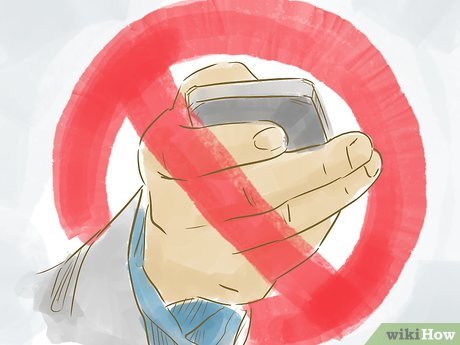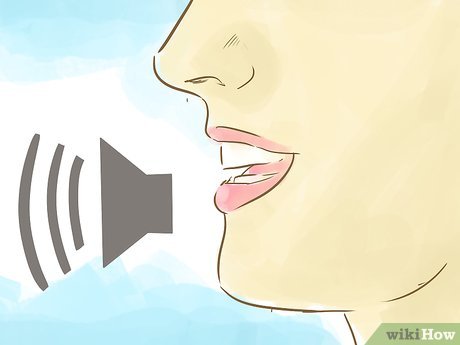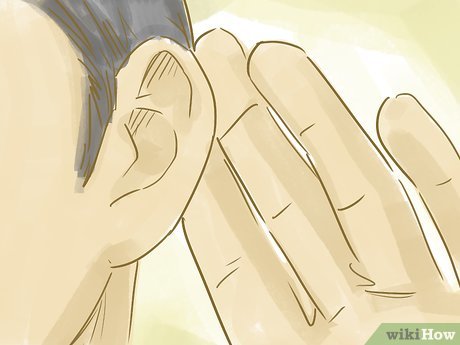How to Communicate Effectively
Part 1 of 5:
Creating the Right Environment
-
 Choose the right time. As the saying states, there is a time and a place for everything, and communicating is no different.
Choose the right time. As the saying states, there is a time and a place for everything, and communicating is no different.- Avoid starting discussions about heavy topics late in the evening. Few people will be thrilled to be faced with sorting major issues like finances or long range scheduling when they are the most tired. Instead, deliver messages and conduct discussions about heavy topics in the mornings or afternoons when people are alert, available, and more likely to be able to respond with clarity.
-
 Facilitate an open, intimate conversation. Choose the right place, one that provides freedom for the communication to open, flower, and come to maturity. If you need to tell someone something that isn't going to sit well (such as news of a death or a breakup), don't do it in public, around colleagues, or near other people. Be respectful and mindful of the person by communicating to them in a private place. This will also provide space to open the dialog into a wider and a more involved mutual understanding and ensure that the two-way process is functioning properly.
Facilitate an open, intimate conversation. Choose the right place, one that provides freedom for the communication to open, flower, and come to maturity. If you need to tell someone something that isn't going to sit well (such as news of a death or a breakup), don't do it in public, around colleagues, or near other people. Be respectful and mindful of the person by communicating to them in a private place. This will also provide space to open the dialog into a wider and a more involved mutual understanding and ensure that the two-way process is functioning properly.- If you are presenting to a group of people, be sure to check the acoustics beforehand and practice projecting your voice clearly. Use a microphone if needed to ensure that your audience can hear you.
-
 Remove distractions. Turn off all electronics that could interrupt the conversation. If the phone rings, laugh it off the first time, then turn it off immediately and continue talking. Do not allow external distractions to act as crutches that sidetrack your concentration. They will distract both you and your listener, and will effectively kill the communication.
Remove distractions. Turn off all electronics that could interrupt the conversation. If the phone rings, laugh it off the first time, then turn it off immediately and continue talking. Do not allow external distractions to act as crutches that sidetrack your concentration. They will distract both you and your listener, and will effectively kill the communication.
Part 2 of 5:
Organizing your communications
-
 Organize and clarify ideas in your mind. This should be done before you attempt to communicate any ideas. If you are feeling passionate about a topic, your ideas may become garbled if you haven't already targeted some key points to stick to when communicating. Key points will act as anchors, bringing focus and clarity to your communication.
Organize and clarify ideas in your mind. This should be done before you attempt to communicate any ideas. If you are feeling passionate about a topic, your ideas may become garbled if you haven't already targeted some key points to stick to when communicating. Key points will act as anchors, bringing focus and clarity to your communication.- A good rule of thumb is to choose three main points and keep your communication focused on those. That way, if the topic wanders off course, you will be able to return to one or more of these three key points without feeling flustered. Writing the points down, if appropriate, can also help.
-
 Be crystal clear. Make it clear what you're hoping to convey from the outset. For example, your purpose could be to inform others, obtain information, or initiate action. If people know in advance what you expect from the communication, things will go more smoothly.
Be crystal clear. Make it clear what you're hoping to convey from the outset. For example, your purpose could be to inform others, obtain information, or initiate action. If people know in advance what you expect from the communication, things will go more smoothly. -
 Stay on topic. Once you start to convey your three main points, make sure everything you're saying adds to the message you intend to communicate and strengthens it. If you have already thought through the issues and distilled the them to the essentials, it is likely that helpful pertinent phrases will stick in your mind. Do not be afraid to use these to underline your points. Even confident, well-known speakers reuse their key lines again and again for emphasis and reinforcement. Remember to keep the overall message clear and direct.
Stay on topic. Once you start to convey your three main points, make sure everything you're saying adds to the message you intend to communicate and strengthens it. If you have already thought through the issues and distilled the them to the essentials, it is likely that helpful pertinent phrases will stick in your mind. Do not be afraid to use these to underline your points. Even confident, well-known speakers reuse their key lines again and again for emphasis and reinforcement. Remember to keep the overall message clear and direct. -
 Thank your listener(s). Thank the person or group for the time taken to listen and respond. No matter what the outcome of your communication, even if the response to your talk or discussion has been other than you had hoped, end it politely by properly respecting everyone's input and time.
Thank your listener(s). Thank the person or group for the time taken to listen and respond. No matter what the outcome of your communication, even if the response to your talk or discussion has been other than you had hoped, end it politely by properly respecting everyone's input and time.
Part 3 of 5:
Communicating with Speech
-
 Set the listener at ease. You want to do this before launching into your conversation or presentation. It can help sometimes to begin with a favorite anecdote. This helps the listener identify with you as someone who acts like them and has the same everyday concerns.
Set the listener at ease. You want to do this before launching into your conversation or presentation. It can help sometimes to begin with a favorite anecdote. This helps the listener identify with you as someone who acts like them and has the same everyday concerns. -
 Be articulate. It is important to deliver your message clearly and unambiguously so that the message comes across in a way that every listener can understand. Your words are remembered because people instantly understand what it is that you are saying. This requires delivering your words distinctly and using simpler words rather than more complex ones.
Be articulate. It is important to deliver your message clearly and unambiguously so that the message comes across in a way that every listener can understand. Your words are remembered because people instantly understand what it is that you are saying. This requires delivering your words distinctly and using simpler words rather than more complex ones.- The goal of articulate communication is to be clear, concise and relevant.
-
 Enunciate clearly. Speak at a volume level that is guaranteed to be heard and that doesn't come across as too quiet or disengaged. Take special care to properly enunciate key points so that you avoid any kind of misunderstanding. If mumbling is a defensive habit that you have fallen into due to fear of communicating, practice your message at home in front of the mirror. It is sometimes best to discuss what you want to communicate with those you feel comfortable with. This helps solidify the message in your own mind. Be aware that any practice or refinement of your wording will help you to build confidence.
Enunciate clearly. Speak at a volume level that is guaranteed to be heard and that doesn't come across as too quiet or disengaged. Take special care to properly enunciate key points so that you avoid any kind of misunderstanding. If mumbling is a defensive habit that you have fallen into due to fear of communicating, practice your message at home in front of the mirror. It is sometimes best to discuss what you want to communicate with those you feel comfortable with. This helps solidify the message in your own mind. Be aware that any practice or refinement of your wording will help you to build confidence. -
 Be attentive when listening and ensure that your facial expressions reflect your interest. Listen actively. Remember that communication is a two-way street and that while you are talking, you are not learning. By actively listening, you will be able to gauge how much of your message is getting through to your listener(s) and whether or not it is being received correctly or needs to be tweaked. If your audience appears to be confused, it is often helpful to ask the listener(s) to reflect back some of what you have said, but in their own words. This can help you to identify and correct mistaken views of what you have intended to communicate.
Be attentive when listening and ensure that your facial expressions reflect your interest. Listen actively. Remember that communication is a two-way street and that while you are talking, you are not learning. By actively listening, you will be able to gauge how much of your message is getting through to your listener(s) and whether or not it is being received correctly or needs to be tweaked. If your audience appears to be confused, it is often helpful to ask the listener(s) to reflect back some of what you have said, but in their own words. This can help you to identify and correct mistaken views of what you have intended to communicate.- Validate people's feelings. This will encourage them to open up, and help them feel better if they're upset.
-
 Be vocally interesting. A monotone is not pleasing to the ear, so good communicators use vocal color to enhance communication. Norma Michael recommends[1] that you:
Be vocally interesting. A monotone is not pleasing to the ear, so good communicators use vocal color to enhance communication. Norma Michael recommends[1] that you:- Raise the pitch and volume of your voice when you transition from one topic or point to another.
- Increase your volume and slow the delivery whenever you raise a special point or are summing up.
- Speak briskly, but pause to emphasize keywords when requesting action.
Part 4 of 5:
Communicating with Body Language
-
 Recognize people. Sure, you don't necessarily know the people in your audience or that new friend in your group, but they're nodding along with you and looking knowingly at you all the same. This means that they are connecting with you. So reward them with your acknowledgment!
Recognize people. Sure, you don't necessarily know the people in your audience or that new friend in your group, but they're nodding along with you and looking knowingly at you all the same. This means that they are connecting with you. So reward them with your acknowledgment! -
 Be clear and unambiguous with your body language, too. Use facial expressions consciously. Strive to reflect passion and generate listener empathy by using soft, gentle, aware facial expressions. Avoid negative facial expressions, such as frowns or raised eyebrows. What is or isn't negative depends on the context, particularly the cultural context, so be guided by your situation.
Be clear and unambiguous with your body language, too. Use facial expressions consciously. Strive to reflect passion and generate listener empathy by using soft, gentle, aware facial expressions. Avoid negative facial expressions, such as frowns or raised eyebrows. What is or isn't negative depends on the context, particularly the cultural context, so be guided by your situation.- Be quick to identify unexpected behavior that suggests a cross-culture collision, such as a clenched fist, a slouched posture, or even silence.[2] If you don't know the culture intimately, ask questions about the communication challenges you might face before you start to speak with (or to) people in an unfamiliar cultural context.
-
 Communicate eye-to-eye. Eye contact builds rapport, helps to convince people that you're trustworthy, and displays interest. During a conversation or presentation, it is important to look into the other person's eyes if possible and maintain contact for a reasonable amount of time. Take care not to overdo it.– Use just as much eye contact as feels natural, about 2-4 seconds at a time.[3]
Communicate eye-to-eye. Eye contact builds rapport, helps to convince people that you're trustworthy, and displays interest. During a conversation or presentation, it is important to look into the other person's eyes if possible and maintain contact for a reasonable amount of time. Take care not to overdo it.– Use just as much eye contact as feels natural, about 2-4 seconds at a time.[3]- Remember to take in all of your audience. If you're addressing a boardroom, look every member of the board in the eye. Neglecting any single person can easily be taken as a sign of offense and could lose you business, admission, success, or whatever it is you endeavor to achieve.
- If you're addressing an audience, pause and make eye contact with a member of audience for up to two seconds before breaking away and resuming your talk. This helps individual members of the audience feel personally valued.
- Be aware that eye contact is culturally ordained. In some cultures it is considered to be unsettling, or inappropriate. Ask about this in particular or do the research in advance.
-
 Use breathing and pauses to your advantage. There is power in pausing. Simon Reynolds says that pausing causes an audience to lean in and listen. It helps you to emphasize your points and allow the listener time to digest what has been said. It also helps to make your communication come across as more compelling and it makes your speech easier to absorb and become comfortable with.[4]
Use breathing and pauses to your advantage. There is power in pausing. Simon Reynolds says that pausing causes an audience to lean in and listen. It helps you to emphasize your points and allow the listener time to digest what has been said. It also helps to make your communication come across as more compelling and it makes your speech easier to absorb and become comfortable with.[4]- Take a few deep breaths to steady yourself before you begin communicating.
- Get into the habit of solid, regular breathing during a conversation, This will help you to keep a steady, calm voice and will also keep you more relaxed.
- Use pauses to take a breather from what you are saying.
-
 Consider how your gestures come across. Use hand gestures carefully. Be conscious of what your hands are saying as you speak. Some hand gestures can be very effective in highlighting your points (open gestures), while others can be distracting or even offensive to some listeners, and tend to shut down the conversation or listening (closed gestures). It also helps to watch other speaker's hand gestures with an eye for how they come across to you. Emulate those you see that are effective and engaging. Notice that the most effective gestures are natural, slow, and emphatic.
Consider how your gestures come across. Use hand gestures carefully. Be conscious of what your hands are saying as you speak. Some hand gestures can be very effective in highlighting your points (open gestures), while others can be distracting or even offensive to some listeners, and tend to shut down the conversation or listening (closed gestures). It also helps to watch other speaker's hand gestures with an eye for how they come across to you. Emulate those you see that are effective and engaging. Notice that the most effective gestures are natural, slow, and emphatic. -
 Keep a check on your other body signals. Be alert to your wandering eyes, your hands picking at fluff, your constant sniffling, shuffling, rocking, and the like. These small gestures add up and are all guaranteed to dampen the effectiveness of your message.
Keep a check on your other body signals. Be alert to your wandering eyes, your hands picking at fluff, your constant sniffling, shuffling, rocking, and the like. These small gestures add up and are all guaranteed to dampen the effectiveness of your message.- Have someone record your talk, then take the time to view your speech delivery in fast forward. Any repetitive gesture or unconscious habit will stand out like a sore thumb and will be somewhat comical. Once you have targeted such a behavior, it will be easier to modify your unintended body language and monitor its reappearance.
Part 5 of 5:
Communicating Effectively When in Conflict
-
 Place yourself on even ground. Do not stand or hover over the other person. This creates a power struggle and pushes the conflict to another level. If they are sitting, you should sit with them.
Place yourself on even ground. Do not stand or hover over the other person. This creates a power struggle and pushes the conflict to another level. If they are sitting, you should sit with them. -
 Listen to the other party. Let them say how they feel. Wait until they are completely finished talking before beginning to speak yourself.
Listen to the other party. Let them say how they feel. Wait until they are completely finished talking before beginning to speak yourself. -
 Speak in a calm, level voice. Don't yell or make accusations about the other party or their actions.
Speak in a calm, level voice. Don't yell or make accusations about the other party or their actions. -
 Let them know you have heard their point and understand their side. Take the time to make statements like, "If I understand correctly, you are saying,..."
Let them know you have heard their point and understand their side. Take the time to make statements like, "If I understand correctly, you are saying,..." -
 Don't try to finish the argument at all costs. If the person walks out of the room, don't follow them. Allow them to do so and let them return when they are calmer and ready to talk.
Don't try to finish the argument at all costs. If the person walks out of the room, don't follow them. Allow them to do so and let them return when they are calmer and ready to talk. -
 Don't try to get the last word in. Again, this could lead to a power struggle that escalates and never ends. Sometimes, you have to agree to disagree and move on.
Don't try to get the last word in. Again, this could lead to a power struggle that escalates and never ends. Sometimes, you have to agree to disagree and move on. -
 Use "I" messages. When you're phrasing your concerns, try to start your sentences with "I..." and state clearly how their actions make you feel. This will make the other person more receptive to your complaints and more empathetic. For instance, instead of saying "You're sloppy and it drives me crazy," try "I feel that different levels of messiness might be a problem for us. Clutter is something that seems to work its way into my mind and limit what I feel I can do. Frankly, messiness seems to unsettle me more than it probably should."
Use "I" messages. When you're phrasing your concerns, try to start your sentences with "I..." and state clearly how their actions make you feel. This will make the other person more receptive to your complaints and more empathetic. For instance, instead of saying "You're sloppy and it drives me crazy," try "I feel that different levels of messiness might be a problem for us. Clutter is something that seems to work its way into my mind and limit what I feel I can do. Frankly, messiness seems to unsettle me more than it probably should."
Conversation Help
 Sample List of Questions
Sample List of Questions5 ★ | 1 Vote
You should read it
- 12 bad habits in dealing with many people
- 10 ways to help you avoid 'miss words' errors when communicating
- How to Measure the Effectiveness of Communication
- How to look up isolated points in the country with Zalo
- Google is about to communicate
- 9 tips to help you become smarter when talking
- What is Google Play Points and how to use Google Play Points
- What is Discord and how to use it?
May be interested
- Communicate with LinkedIn members
 in this tutorial, we will introduce you to the basics of linkedin and some ways to communicate with other members.
in this tutorial, we will introduce you to the basics of linkedin and some ways to communicate with other members. - What is RPC Server is Unavailable Error? How to fix it effectively
 the 'rpc server is unavailable' error usually appears when a windows computer is unable to communicate with other devices on the same network.
the 'rpc server is unavailable' error usually appears when a windows computer is unable to communicate with other devices on the same network. - How to Communicate Well With People from Other Cultures
 to build good relationships with people from other cultures, it is essential to learn how to communicate with them verbally and non-verbally. you can make things easier by also learning about their culture and practicing tolerance. armed...
to build good relationships with people from other cultures, it is essential to learn how to communicate with them verbally and non-verbally. you can make things easier by also learning about their culture and practicing tolerance. armed... - Decipher the strange behavior often seen in dogs
 let's learn some of the behaviors that puppies often do to understand more about these close friends of humans.
let's learn some of the behaviors that puppies often do to understand more about these close friends of humans. - Grammarly - Download Grammarly here
 grammarly's ai-powered apps help people communicate more effectively. millions of users rely on grammarly every day to make their messages, documents and social media posts more legible, error-free and professional.
grammarly's ai-powered apps help people communicate more effectively. millions of users rely on grammarly every day to make their messages, documents and social media posts more legible, error-free and professional. - 8 professional email signature tips
 don't miss the opportunity to advertise personal images by creating professional email signatures because this is a way to communicate with customers very effectively.
don't miss the opportunity to advertise personal images by creating professional email signatures because this is a way to communicate with customers very effectively. - Common terms used by gamers in Mobile Union
 in the mobile coalition, there are many short terms that help you communicate quickly and effectively when playing. and then, the joint council will review the most basic terms so that the masters can grasp.
in the mobile coalition, there are many short terms that help you communicate quickly and effectively when playing. and then, the joint council will review the most basic terms so that the masters can grasp. - Instructions allow applications to communicate with each other via Windows Firewall
 windows firewall acts as a barrier to prevent your computer from connecting to the rest of the internet. the firewall retains unwanted network traffic and allows applications on your computer to communicate with the outside world. but each fence needs a gate, and that's where exceptions come in.
windows firewall acts as a barrier to prevent your computer from connecting to the rest of the internet. the firewall retains unwanted network traffic and allows applications on your computer to communicate with the outside world. but each fence needs a gate, and that's where exceptions come in. - Intel shook hands with AMD to release the 8th generation chip competing with Nvidia
 the two rivals amd and intel decided to join forces to design mobile processors for the 8th generation h-series series that combine the strengths of both sides and help the two parties communicate more effectively.
the two rivals amd and intel decided to join forces to design mobile processors for the 8th generation h-series series that combine the strengths of both sides and help the two parties communicate more effectively. - How to fix Outlook error 0x800CCC0E
 microsoft outlook is a popular email application used by many people to send and receive messages, organize meetings, and stay in touch with contacts. it's an easy way to communicate comfortably and effectively.
microsoft outlook is a popular email application used by many people to send and receive messages, organize meetings, and stay in touch with contacts. it's an easy way to communicate comfortably and effectively.



































 How to Transfer from a Community College to a University
How to Transfer from a Community College to a University How to Succeed in College with Young Children
How to Succeed in College with Young Children How to Transition from High School to College
How to Transition from High School to College How to Apply to University of Toronto
How to Apply to University of Toronto How to Return to School in Your Fifties
How to Return to School in Your Fifties How to Crash a Class in College
How to Crash a Class in College